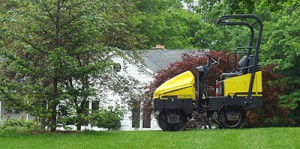What Does Lawn Rolling Do?

We use a 3000 pound vibrating asphalt roller for lawn rolling. The roller does a good job of knocking down mole tunnels, fixing minor tire ruts, and smoothing out areas that heaved during the winter. Results are best when there is moisture in the ground.
Lawn rolling can compact the soil to a depth of 10 inches. Core aeration is highly recommended after lawn rolling since this kind of compaction can damage the root system of the lawn. Aeration relieves the compaction pressure and sets up an ideal condition to apply gypsum if your lawn needs it.
In a perfect world we would roll all of our clients right after the snow melts or in a nice rain. The reality is that we are the only lawn care company in Grand Rapids that owns an asphalt roller. It takes us six to eight weeks to get through all of our clients each spring.
Things to Consider Before We Roll.
We request that all underground sprinkler heads, valve boxes, invisible dog fences, and shallow wiring for landscape lighting be flagged. Flags can be purchased at Home Depot, Menards, and Lowes for a very low price. We are not responsible for damage to buried items like sprinkler lines, sprinkler heads, valve boxes, buried utility wires (such as for landscape lighting), invisible dog fences, septic tanks and drain fields.
We have not had any problems with rolling over septic tanks and drain fields, but we prefer to avoid them if possible. Most sprinkler heads are buried deep enough in the ground that we don’t hit them, but that is a decision the client has to make on whether they want to take the chance.
Since we cannot control the weather, we provide all of our clients with an email a week in advance. We follow that up with an email the day prior to service as a reminder. The advance notice gives you time to get ready to water the lawn if we have dry conditions. This also give you time flag any buried items for our attention when we arrive.
What Lawn Rolling Won’t Do.
The roller does not grade lawns. It will not take high places and fill in low spots. It will not fix all tire ruts. The lawn roller was meant to operate on flat asphalt, so it does not handle hills in a lawn too well. The roller can go up and down hills, but not traverse them. It can climb the hill of a walk out basement, as long as the slope is not straight up and down. If the hill slopes to a fence we may not be able to go up or down it.
The roller is 4 feet wide and has a roll bar that needs 8 feet of clearance. We will not drive it over patios, brick walkways, steps, or landscaping.


